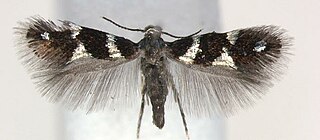
Batrachedra is the largest genus in the moth family Batrachedridae, with representatives all over the world. The early stages of most species are unknown. The genus name is derived from the Greek words batrachos, 'frog', and edra, 'seat', referring to the frog-like resting posture of the adult moths. As of 2018 at least some 114 species are known to belong to the genus.

The Heliozelidae, commonly known as shield-bearer moths, are a family of small, day flying monotrysian moths distributed worldwide. The larvae of most heliozelid species are leaf miners who cut distinctive shield-shaped cases from the surface of the host leaf, hence the common name. Some species are considered pests of commercial crops such as grapevines, cranberries, and walnuts. The taxonomy of this family is poorly understood.

Islands, such as the British Isles, can be adversely affected by the introduction of non-native species. Often an island will have several distinct species not present on the nearest mainland, and vice versa. The native flora and fauna of islands which have been isolated for a longer period of time such as New Zealand or Hawaii are more vulnerable than islands such as Great Britain and Ireland, which became isolated more recently.

Prorocopis is a genus of moths of the family Noctuidae. The genus was erected by Edward Meyrick in 1897. All the species in the genus are known from Australia.

Anatrachyntis is a genus of moths in the family Cosmopterigidae. Some authors include it in Pyroderces.

Labdia is a genus of moths in the family Cosmopterigidae.

Musotima nitidalis, also known as the golden brown fern moth, is a species of moth of the family Crambidae. This species was described by Francis Walker in 1866. It is native to Australia and New Zealand and was first found in Europe in 2009.

Labdia anarithma is a moth of the family Cosmopterigidae. It was described by Edward Meyrick in 1888. It is found in New Zealand and throughout Australia. Adults are on the wing from December to March and are day flying. They have been collected by sweeping bracken fern.

Calicotis is a genus of moths in the family Stathmopodidae, although it is sometimes included in the family Oecophoridae. In 2024, the genus Pachyrhabda was synonymised with Calicotis.

Pachyrhabda is a former genus of moths in the family Stathmopodidae. In 2024, this genus was synonymised with Calicotis.
Herpetogramma platycapna is a species of moth in the subfamily Spilomelinae of the family Crambidae. It was described by Edward Meyrick in 1897. It is found in Malaysia, Indonesia (Sulawesi), New Guinea, the Keeling Islands and Australia, where it has been recorded from the Northern Territory.

Stathmopodidae is a family of moths in the moth superfamily Gelechioidea described by Edward Meyrick in 1913.

Oenoe is a genus of moths belonging to the family Tineidae.
Illidgea epigramma is a moth in the family Xyloryctidae. It was described by Edward Meyrick in 1890. It is found in Australia, where it has been recorded from the Australian Capital Territory, New South Wales, Queensland and South Australia.
Pachyrhabda bacterias is a moth of the family Stathmopodidae first described by Edward Meyrick in 1913. It is found in Sri Lanka and Australia.
Pachyrhabda dicastis is a moth of the family Stathmopodidae first described by Edward Meyrick in 1905. It is found in Sri Lanka.
Pachyrhabda tumida is a moth of the family Stathmopodidae first described by Edward Meyrick in 1913. It is found in Sri Lanka and Australia.
Aphendala ferreogrisea is a moth of the family Limacodidae first described by Edward Meyrick in 1913. It is found in Sri Lanka, and Australia.

Psychoides filicivora is a moth of the family Tineidae first described by Edward Meyrick in 1937. First found in Ireland in 1909, it is possible that the moth was introduced from imported ferns from Asia. The moth can be found from spring though autumn in a series of generations. The species overwinters as a larva.
Calicotis antinoma is a moth of the family Oecophoridae first described by Edward Meyrick in 1910. It is found in New Zealand at the Kermadec Islands and has also been collected in Australia.












